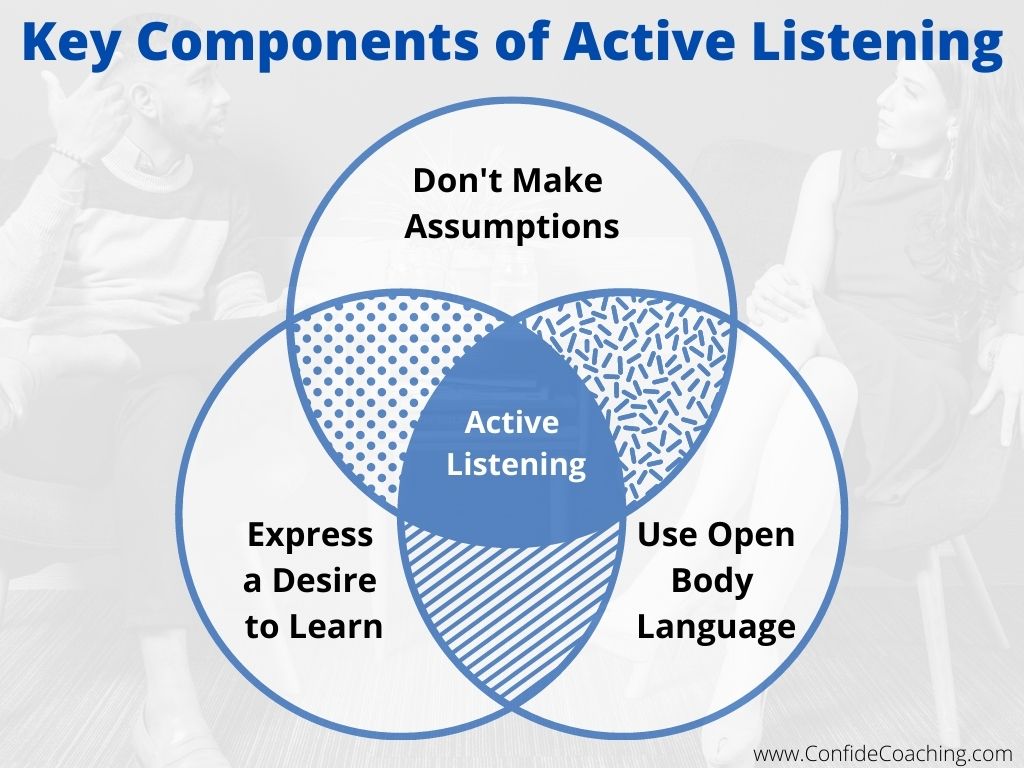
Active listening by definition means using your whole self – body and mind – to establish a connection with someone else.
It is something of a cliché that most people don’t listen, they only wait for their turn to talk. In truth, the very first step to building rapport is to assume the other person has good intentions.
Knowing this, it may be more helpful to think along these lines: Most people do want to communicate effectively with others, and they realize listening is key to that goal. But not everyone has been shown the tools that take listening from a passive behavior to an engaged, active one.
In fact, active listening is only practiced regularly by a small fraction of people. That is true in both business and personal contexts. When there is no commitment to active listening on both sides of an exchange, serious misunderstandings can arise even when people are broadly in agreement.
In a contentious situation, such as mediating a dispute, this effect becomes even more pronounced. Yet, at the same time, people are less apt to use active listening in situations they perceive as a threat to their status!

Precisely What Is Active Listening?
Before we can discuss exactly what active listening is, let’s take a look at what it enables you to do:
- Hear the other person or people
- Fully integrate what they have to say
- Respond effectively in your turn
Many different techniques can further your goal to practice active listening. More than anything else, however, active listening is about giving the other person your full and undivided attention. At its basic level, your active listening is shown by the fact that you are focused on nothing else in your environment.
This can be challenging for the active listener – and surprising for the person being listened to.
In fact, just as many people have not built a habit of active listening, most people are not exactly acclimated to being completely heard. Active listening asks that you aspire toward laser focus on the other person. Since this can be intimidating at first, there are various techniques you can use to soften and humanize it.
At the same time, using these techniques makes active listening easier and easier for you. If you are motivated and stay attuned to others, active listening can become an effortless habit that you engage at will.

Real World Example
Personal Note from the Author:
“Growing up, you really had to compete to get into the conversation at the dinner table. It was very difficult to make a point between my brother and my father who both love to talk. Fast forward to my 20’s, and I realized how little I listened to others – I was quick to interrupt before they completed a thought. Learning to sit back and really listen was a skill I’ve had to work on and develop.”
How to Practice Active Listening in Any Situation – at Work or at Home
Active listening begins with the tenets of basic politeness, such as making sure everyone has sufficient time to speak and then allowing them to speak, even if what they have to say is unpleasant or uncomfortable. In short, the other person must be allowed to “speak their truth.”
Let’s assume that you are in an environment where there are no major, pre-existing barriers to communication. You and the other person both feel free to speak. How do you “practice” active listening?

Three Key Components
1. Use Open Body Language
Even when you are silent, your body communicates a great deal. When a conversation starts, check your body from head to toe. Are your arms crossed? Your legs? Are you slumping forward? These are closed-off signals, while leaning back makes it appear you do not care about the other person.
Face the speaker and use signs like nodding or brief comments to show you are listening. Fight misunderstandings with mirroring: “If I understand correctly, you’re saying …” and restate the person’s main points. This also helps encourage nervous speakers at work.
2. Ask Questions and Show a Desire to Learn
Each person brings a unique perspective to every act of communication. If you ask yourself, “What can I learn from this person?” you may feel more energized to listen closely to another’s words. If anything is not clear, solicit information – that is, ask questions.
Avoid closed-off “yes or no” questions. “How did you come to that conclusion?” is one useful question: People are often eager to explain their reasoning. While doing so, any strong emotion they’re feeling may start to wind down.
3. Make No Negative Assumptions
Last, but certainly not least, resist the temptation to make any assumptions about what someone will say – or even what it means. Strive to stay focused even if someone is upset or has a complaint. Do not assume you are being blamed or your position is being threatened.
It is impossible to listen to someone else if you are also listening to your inner critic. Embrace a collaborative approach and regard the other person as your ally. This can be valuable when dealing with conflict in a relationship: What may first look like a snub or slight might simply mean you need to clarify your expectations.
p.s. – Would you like to learn more about how to more effectively use active listening in your life or career? Click here to book a free trial session.

Paul Strobl, MBA, CPC
Owner of Confide Coaching, LLC
Paul is a Master Life Coach for individuals, executives and business owners. Originally from Houston, Texas, he has been location independent for most of his adult life. He currently resides in the Rhodope Mountains of Bulgaria near the Greek border with his brilliant wife, 13-year-old stepson (officially adopted in 2021!) and a Posavac Hound rescue.

